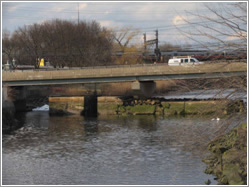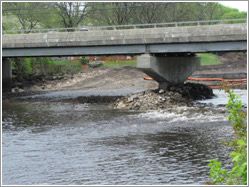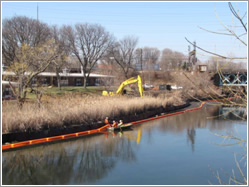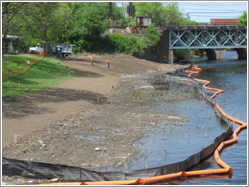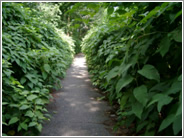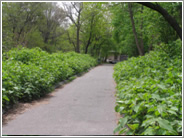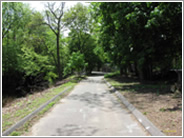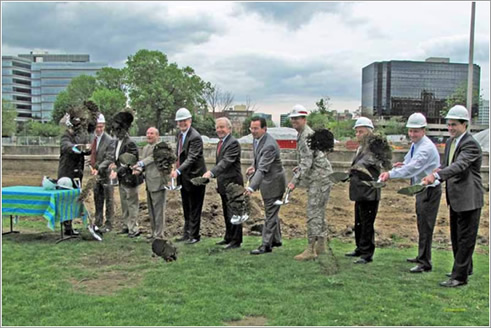The Restoration Of Mill River Is Moving From South To North First at Pulaski Street, the remnant dam under the Pulaski Bridge was removed. A gentle cobble stone ramp that will facilitate upstream fish migration during the majority of the tide cycle in the future removing one of the two obstacles to fish migration in the lower reaches of the Mill River.
Just upstream, stands of invasive phragmites (the tall reeds) and Japanese knot weed were removed. The area was regarded so it is under salt water frequently, a condition in which phragmites does not thrive. In its place, salt marsh plants including spartina and have been planted and protected with a goose exclusion enclosure. Further up the bank, riparian and upland shrubs and plants are going in including low bush and high bush blueberries and chokeberry.
At Richmond Hill Avenue by the West Stamford Cemetery a similar salt marsh restoration is taking place. Phragmites has been removed and the new salt marsh has been planted and protected. Phragmites and Japanese knotweed are listed as invasive species. They are detrimental to the environment because when uncontrolled they create a monoculture where no other plant species can survive, undermining one of the basic tenets of a sound ecology – diversity. Japanese knotweed is particularly difficult to eradicate. Its roots go four feet underground and form colonies. If you kill one shoot, another will pop up somewhere else. The roots store a tremendous amount of energy and successful eradication involves starving the roots by reducing the above ground photosynthesis. In anticipation of the restoration of the river banks, the Collaborative’s Land Manager, Vincent Piselli, with the help of the Student Conservation Association and other volunteers, cut the knotweed monthly for several years. At the end of each growing season, an approved herbicide was applied while the plant was at its weakest.
A very large stand of knotweed along the river path at Wright Tech, has finally, nearly, been defeated. It was so well established that it has taken many years to weaken. The pictures above were taken in 2003, 2006 and 2009, respectively from left to right. New trees and shrubs will be planted now that the invasives are gone. Japanese knotweed does not thrive in shade, so increasing the tree canopy is one measure to reduce its return. It is essential to remove the invasive species before planting the new native trees, shrubs and plants that are planned for the restored river banks. It would perhaps be impossible to remove if it were growing among newly installed plants. Next stop – the Mill Pond On May 18th nearly 100 people attended the official groundbreaking for the restoration of Mill River & the Mill Pond. With downtown in the background and the park now clearly a construction site, civic and political leaders came together to celebrate the freeing of the Rippowam (Mill) River from its industrial past. By the end of the year, after 350 years of being dammed for industry, the river will run freely for the first time since the colonial period. (See the history of Mill River Mills under news.) The groundbreaking was attended by Senator Joseph Lieberman, representing the Connecticut congressional delegation that has secured the federal funding for the river restoration, Colonel Philip T. Feir, Commander of the New England District of the Army Corps of Engineers, Mayor Dannel T. Malloy, who has made fixing the Mill River and the creation of the park one of his top priorities, and Arthur Selkowitz, Chairman of the Mill River Collaborative. Mayor Malloy pointed out that the idea for the currently planned Mill River Park & Greenway was first put forward in 1891 and reported in Stamford in the Gilded Age by Estelle F. Feinstein.
|
||||||||||||||||||||
